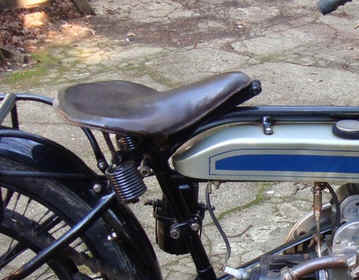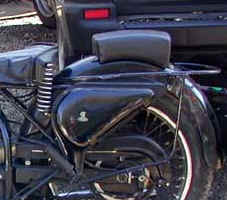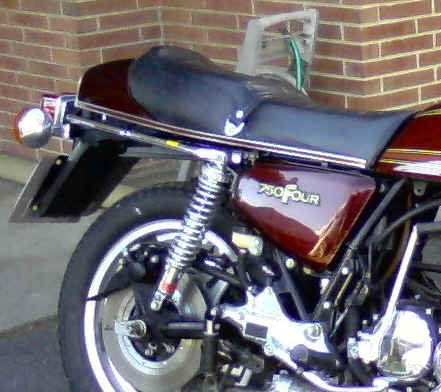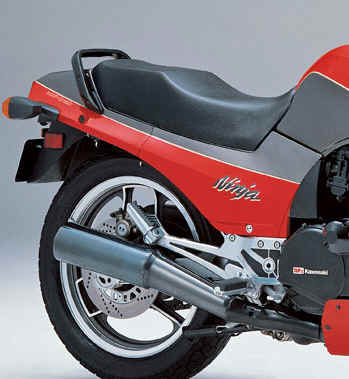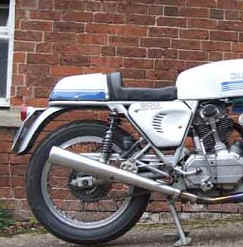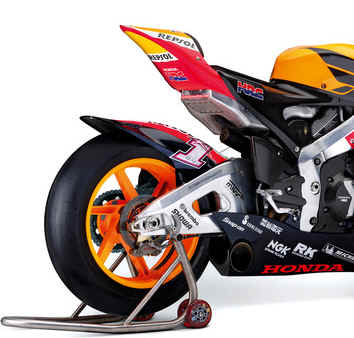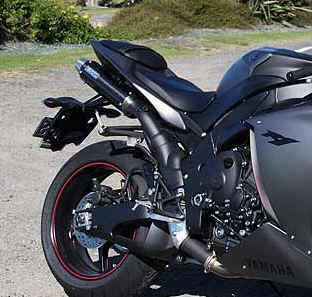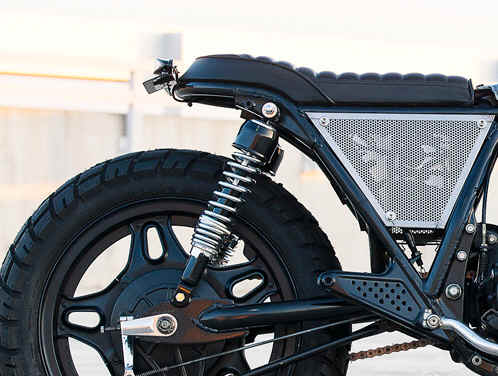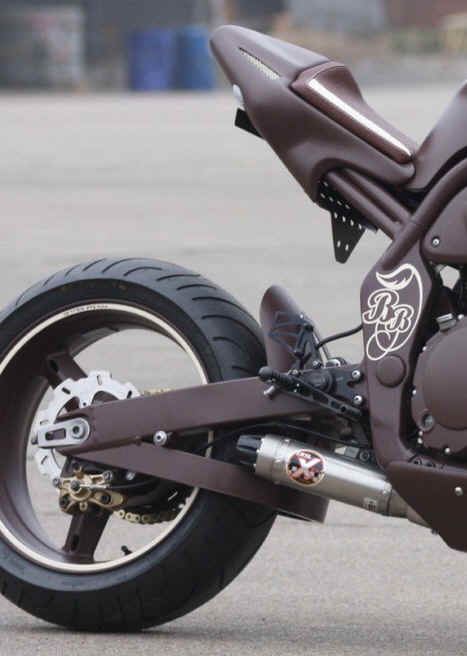The curious case of the disappearing tail – With Phil Hall
(For best effect, this article is best read in a David Attenborough voice.
To assist readers in doing so, I have enclosed each paragraph in inverted commas)
“Since the first motorcycle evolved, some 27 million years ago, there have been aspects of its design that have remained constant. Its two wheels, for example, and the use of handlebars of some sort to control its movement. However, in almost every other aspect, the motorcycle has evolved into a dramatically different vehicle than the one that first rode out of the ooze eons ago. Nowhere is this better illustrated than in the area of its seat.”
“To begin with, we see that the place where the rider sat was first thought to be best made as a copy of a horse’s saddle, since most early riders would be familiar with this concept. However, since early motorcycles did not have any sort of suspension, it was quickly realised that the comfort level of the rider would be very low if the saddle was simply bolted straight to the frame. So springs were added, somewhat copying the saddles of tractors that featured a similar concept. Indeed, the comparison was a valid one since both vehicles were about as slow and uncomfortable. Keen students of motorcycle evolution will have noted that some modern motorcycles have become trapped in an evolutionary time warp and so still use this type of seat. They will also have noted that the tractor comparison is still a valid one.”
“A few hundred millions years later we see the first appearance of seats that are more similar to those with which we are used today. As riders began to travel longer distances, motorcycles evolved more comfortable seats with better padding. It should be added here, however, that the pillion passenger seems to have been by-passed in these early models, these poor unfortunates being compelled to sit on a small pad over the back wheel, like an afterthought in the evolutionary process. Keen students of motorcycle evolution will again note that modern motorcycles seem to have returned to this concept, almost as an example of retro-evolution. Nevertheless, we will return to this quirk a little later.”
“Soon after (a matter of several million years – evolution is a very slow process) what we would regard as proper motorcycle seats started to appear. They were large, flat, well-padded and provided fair degrees of comfort for both the rider and for the passenger should he/she decide to venture on board. And so we entered into a period of relatively little change that lasted quite a long time.”
“History tells us that the early “superbikes” like the Honda 750/4 and the Kawasaki Z1 had such seats and that, despite having performance levels far in excess of what had gone before, the process of evolution seems to have plateaued and that the comfort of the rider still seemed to be of some importance. But then a change began to occur again. As motorcycle racing became better publicised, riders began to demand bikes that more closely resembled the bikes that were being ridden on the track. And one of the features that had evolved in the very specialised mutation of racing bikes was a return to tiny and uncomfortable seats. In an effort to reduce weight (an increasingly contentious issue in the evolutionary process) bikes evolved without the usual creature comforts that had become the norm for road riders. And one of those creature comforts was a comfortable seat.”
“It didn’t take long (just a few million years, in fact) before bikes like the Ducati 900SS and the Honda CB1100R appeared, each more closely resembling the specialised racing bikes of evolutionary heroes like Agostini and Haslam. And, as if by a process of inertia, more and more bikes evolved that began to look more like a racing bike than a road-going everyday bike.”
“Once this process started, evolution appears to have speeded up for reasons that we still don’t quite understand. Into the 1980’s (5 seconds ago in evolutionary terms) bikes like the GPZ Kawasaki still had conventional, comfortable seats but they were being increasingly seen as dinosaurs, hanging on grimly to their existence against the encroaching tide of race bike replicas that offered ballistic performance and increasing levels of discomfort. The GSX-R Suzuki and the first model Fireblade, followed by the Yamaha R1 finally asserted the dominance of the smaller, nimbler, more competitive bikes and the comfortable seat was only to hang on into the modern era in the specialised evolution of sports/touring and touring motorcycles.”
“Once started, the process gathered momentum quickly. Pretty soon it became almost impossible to buy a motorcycle that didn’t have a seat that was about the size of a postage stamp and which had all the comfort of a house brick wrapped in vinyl. Soon the roadsides were littered with groups of sports bike riders, pulled over to the side of the road, trying, by whatever means possible, to ease the aching muscles and the pained posteriors. It should be noted that touring bike riders, whose mounts had resisted the evolutionary surge and had continued to provide comfortable seating, (see above) were nearly always seen to be cruising past their unfortunate cousins and wondering why they seemed only able to travel such short distances before having to stop and seek relief.”
“The evolution of the vestigial seat had some other unfortunate by-products. Firstly, it returned pillion passengers to an impossible position, perched high above the rider, seated on a tiny pad on the back mudguard and with their knees tucked up around their ears somewhere. Churlish ones amongst us would question why the riders of these bikes would want to carry a passenger since their bikes had plainly evolved to the point where they were completely unsuitable for the purpose, but, even today, it is a common sight on our roads, so, who knows?”
“Secondly it had an unfortunate spin-off in the area of motorcycle racing. As bikes evolved more aggressively into the race-replica genre, finding places to attach a number to the bike so that it could be identified on the track became more and more problematical. The tail-piece was now so small that any number placed there was only clearly visible from a distance of 2 or 3 centimetres and placing the racing numbers on the fairing as an alternative also became more difficult as fairings evolved into smaller and smaller pieces of fibreglass. Technocrats (who by now had assumed almost complete control of all aspects of racing) argued that, since electronic timing now displayed that information and a whole lot more on the TV screen at the track or in your pit box, racing number visibility was a dead issue.”
“Thirdly, the evolution of the racing seat impacted heavily upon motorcycle styling. Other factors appear to have intruded here like forward weight bias and aerodynamics, but we will confine ourselves to the end under discussion. At this evolutionary stage we have a bike that is almost totally front heavy. (As a matter of interest, most students point to the Suzuki Katana as the pioneer of this ‘hunched forward’ school of styling.) In any event, these bikes, with their teeny, tiny seats and their owners’ insistence on removing rear number plate hangers and indicators, now have a vacant, unfinished look. With the seat having evolved to be not only smaller but also higher and higher above the rear wheel, the bikes now resemble an odd sort of axe. A huge head and with a tiny handle, as one scientist described it.”
“Nowhere is this absurdity more obvious than in the current cafe racer/bobber/custom bike area. ‘Stylists’, given free rein to cut, chop and weld are now contributing to an evolutionary process that sees some creations almost completely bereft of a seat at all. And don’t get me started on the streetfighter genre. While most modern bikes look like they have been given a swift kick up the backside by a size 15 boot, the S/F brigade seems to have made this idea the centrepiece of their styling.”
“Evolution is a strange thing, as we all know. Who knows where motorcycling and motorcycle style will be in another million or so years? At our point in time, the tail appears to have almost disappeared. In the future, experts on the subject will perhaps make some more sense of it than what appears possible at the moment. They may even give our period a name all of its own, a name that reflects the era when the tail of the motorcycle disappeared. I wonder what that name will be?”
